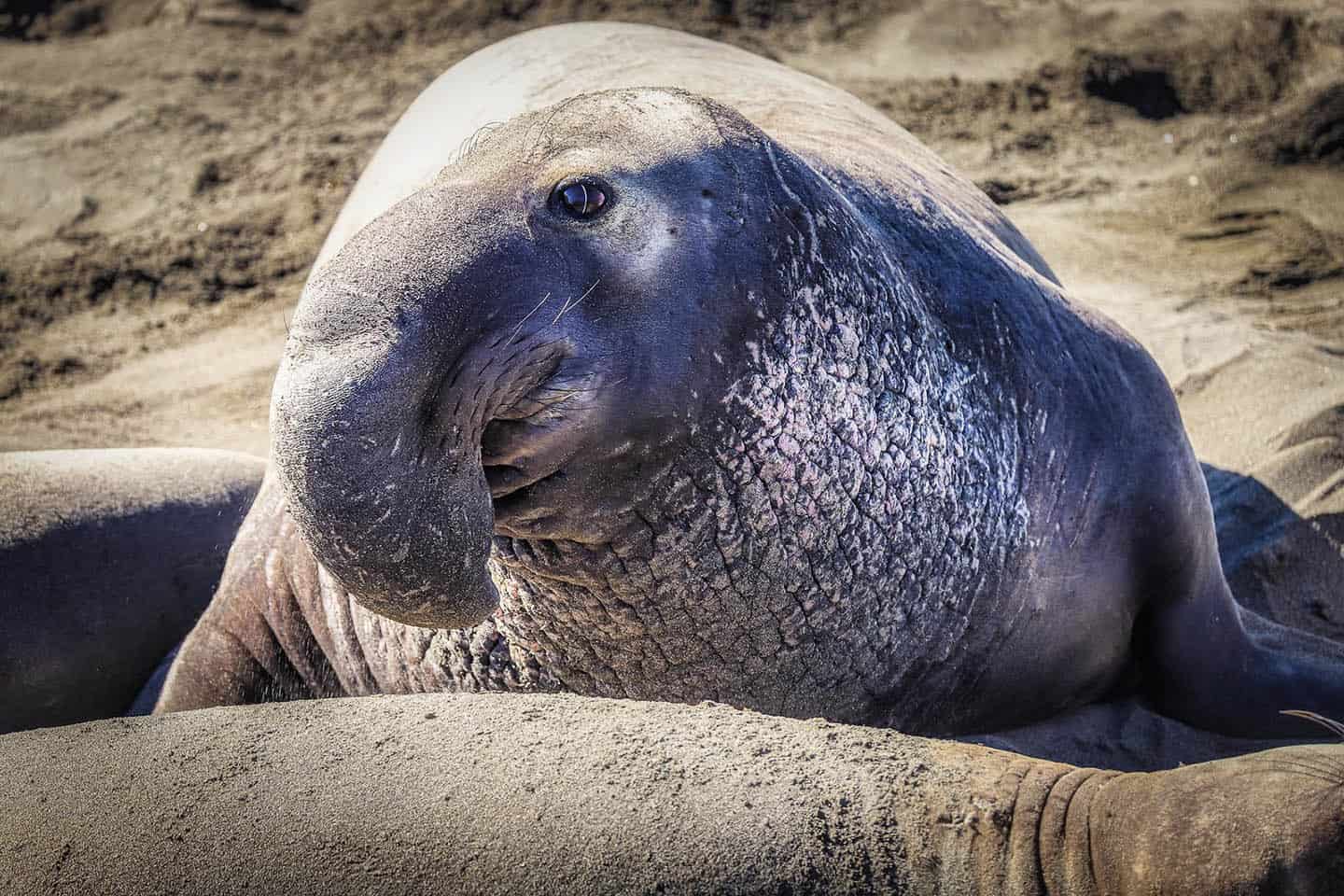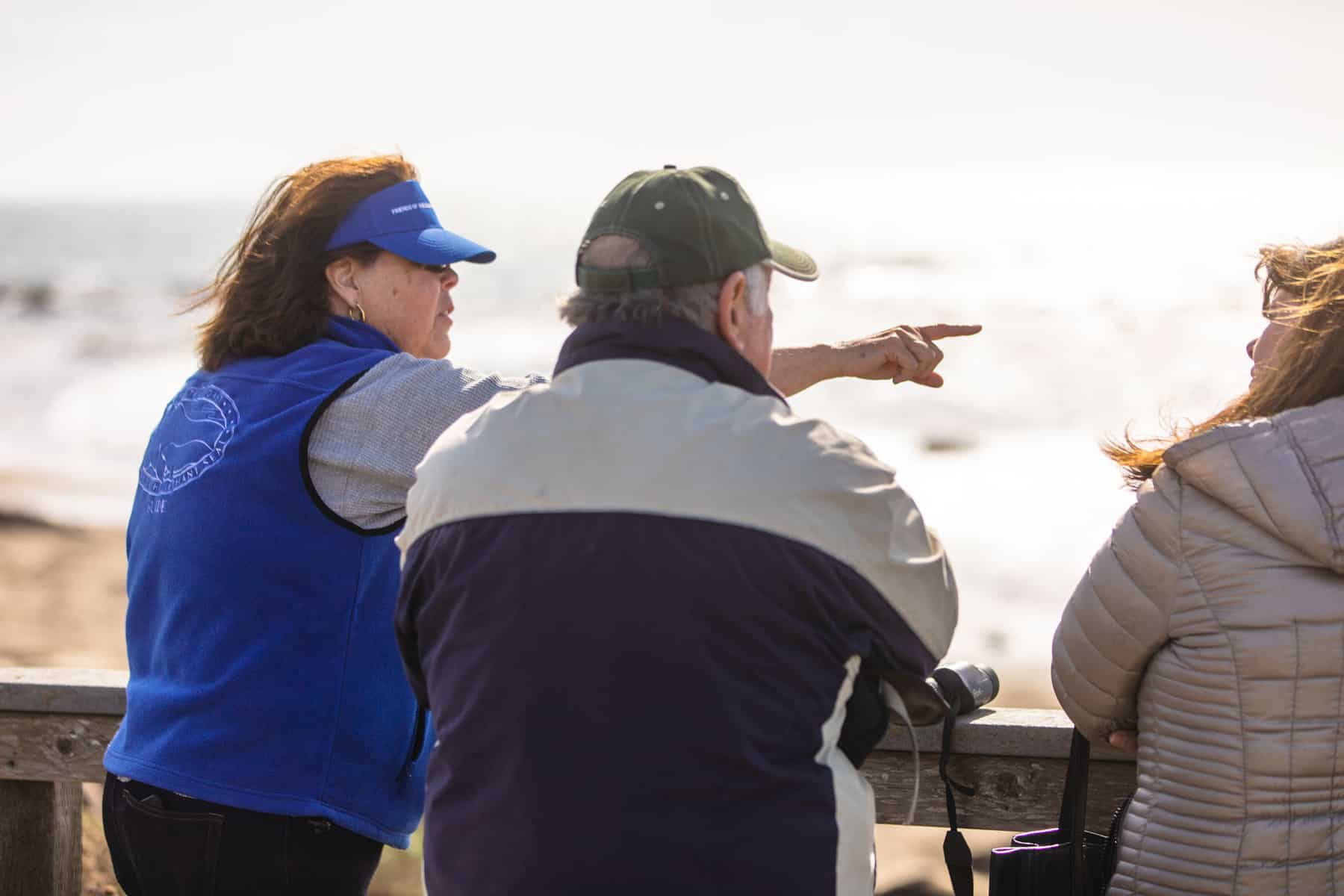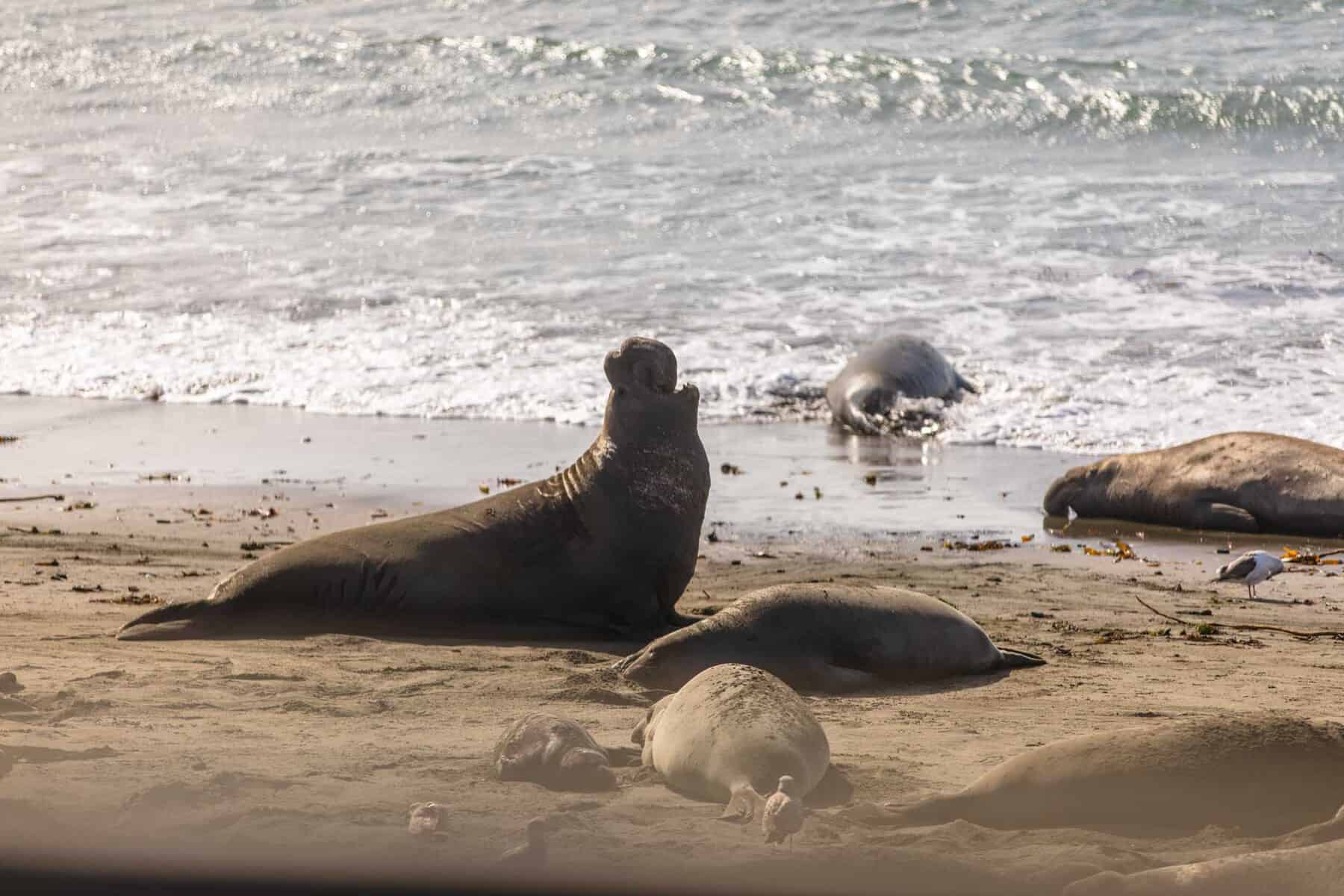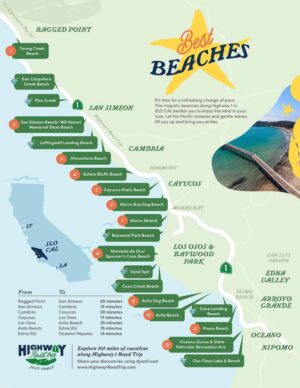From Sarah Kuta at Smithsonian Magazine

Volunteers with Friends of the Elephant Seal educate tourists to prevent conflicts, inspire awe and keep the marine mammals safe
I hear them long before I see them.
As I clamber out of my car in the parking lot near Point Piedras Blancas just off California’s Highway 1, the grunting noises of dozens of elephant seals fill the air. I walk quickly to the wooden viewing platform, lean up against the railing and scan the shallow water lapping against the Pacific Ocean coastline. Is that brown blob a seal? Darn, just a rock, I think to myself.
I wander over to where a handful of people are peering through binoculars or snapping photos on their phones. Then, I spot the mother lode: Roughly a dozen hulking creatures, so named for their elephant-trunk-like proboscises, are lounging on the sand or waddling to and fro. Occasionally, two elephant seals tip their necks back, open their mouths wide and begin ramming into each other. I watch in awe, amazed at the sheer force of their toothy blows—though they don’t appear to be seriously injuring each other.
“Those are juvenile males practicing their sparring,” says a woman wearing a blue jacket.
I peer down at her coat, which identifies her as a docent with the Friends of the Elephant Seal. Since the late 1990s, the nonprofit has been protecting the elephant seals and educating the public in hopes humans and the marine mammals can coexist peacefully.

And, by nearly all accounts, the nonprofit has succeeded. Elephant seals are not only a conservation success story, having come back from the brink of near-extinction. But, along this rugged stretch of coastline in Central California, they’re also a rare example of humans coming together to put wild animals first.
In other places, humans often ignore the needs of animals—or, worse, go out of their way to interfere with them. This can have devastating consequences for both species. If provoked or cornered, wild animals may attack humans and cause serious injuries or even death. For example, tourists in the West sometimes venture too close to elk for photos, and the animals charge. That may, in turn, prompt wildlife officials to euthanize the animals.
Even seemingly innocuous encounters can prove dangerous. Over time, wildlife can start to lose their natural fear of humans and behave dangerously. And, sometimes, humans think they’re being helpful to animals when they’re really harming them. For instance, Yellowstone National Park rangers euthanized a baby bison earlier this year after a man visiting from Hawaii touched it and tried to push it up a riverbank. Sadly, after this encounter, the herd abandoned the newborn, and it began approaching cars and vehicles. The man did not act “maliciously,” according to the National Park Service, but still likely cost the young bison its life. He was eventually fined more than $1,000.
Along the central coast of California, however, volunteers have worked hard to prevent these and other similar scenarios from occurring with the elephant seals.
“It’s not perfect here by any means, but we watch the bison in Yellowstone like everyone else and just shake our heads,” says Kathleen Curtis, president of the Friends of the Elephant Seal board. “The situation in our area 25 years ago was actually very similar, but through the collaborative efforts of a village of organizations and people who saw things could be different, they were able to protect these animals.”
Elephant seals make a comeback

Today, an estimated 150,000 to 200,000 northern elephant seals exist in the wild, inhabiting the waters of the North Pacific as far north as Alaska and as far south as Baja California. But it wasn’t always this way.
Starting in the early 19th century, hunters began systematically killing the marine mammals and harvested their blubber for oil. By the 1880s, they had decimated the population to the point of near-extinction. A small group, however, persisted on Guadalupe Island off the coast of Baja California in Mexico. In the early 20th century, the United States and Mexico banned hunting, which allowed that colony to proliferate.
By the mid-1950s and early 1960s, elephant seals began showing up in California, arriving first at Año Nuevo Island before expanding to the mainland. At Point Piedras Blancas, situated on the Pacific Coast about halfway between Los Angeles and San Francisco, the seals began to hang out on the beaches starting in the early 1990s. In February 1992, the area welcomed its first pup. Since then, the Piedras Blancas population has skyrocketed to an estimated 25,000 individuals who share roughly eight miles of coastline.
Here, the seals follow a predictable, seasonal pattern. In December and January, gigantic males begin arriving on the beaches to fight and prove their alpha status. By mid-February, the biggest, strongest males mate with between 20 and 50 females, which form a harem. The females give birth roughly 11 months later, then spend about a month on the beach raising their pups before getting pregnant again.
Both males and females spend most of their lives at sea, diving deep under the water to feast on fish, squid, sharks and rays. They’re streamlined super-swimmers perfectly adapted for this lifestyle. They can dive to between 1,000 to 2,500 feet deep, and they usually spend 20 to 30 minutes underwater before swimming to the surface for a quick breath. “They’re just these incredible athletes in the ocean,” says Heather Liwanag, a biologist at California Polytechnic State University. “They look so awkward on land, but that’s because they’re really meant to be in the water.”

Elephant seals only come on land twice a year—once for breeding, and another time for molting (when they shed their skin and hair). Their timing is staggered, depending on their age, social status and, for females, when they got pregnant. This means elephant seals are nearly always present on the beaches of Piedras Blancas, which also makes them a year-round tourist attraction. “They’re really charismatic mega-fauna—you just don’t run into these things every day, they’re very unusual,” says Christine Heinrichs, who’s been a volunteer docent since 2007. “That’s one of the gifts of being out there as a docent, because you get to tell people about these creatures. And they’re astonished and amazed and delighted.”
How the nonprofit helped the seals
By the mid-1990s, the growing elephant seal population at Piedras Blancas had started to attract attention. Curious onlookers began pulling over on the side of busy Highway 1, creating dangerous traffic situations at times. They wandered right up to the seals to get a closer look—and, sometimes, they even tried to touch the behemoth creatures. Photographs taken between 1994 and 1997 show small crowds standing on the beach next to the seals. “People were walking down the bluffs, onto the beach, milling around with the seals, putting their kids on the elephant seals’ backs and taking Polaroid photos,” says Michele Roest, a wildlife conservation biologist who teaches at Cal Poly and Cuesta College and serves as a community liaison for the Monterey Bay National Marine Sanctuary. “It was just chaos.”
This type of behavior is bad for the seals because, many times, it prompts them to flee or even dart hurriedly into shallow water. Elephant seals fast when they are on land for weeks or months at a time, and disruptions cause them to waste precious energy. If mothers are still nursing, they may abandon their pups if disturbed, says Curtis.
But humans can also put themselves in danger. Elephant seals can weigh up to 4,400 pounds, and they have powerful jaws and teeth. They’re also faster than they look. “This is not an animal you want to fool with,” says Heinrichs. “Even the small ones are enormous. Tourists say, “Oh, they’re really cute.’ Yes, they’re really cute, but from a distance. Because they’re actually really big, and a bite—even from a pup—can be a really serious wound.”
The Marine Mammal Protection Act, enacted in 1972, made it illegal to harass elephant seals and other animals, but that wasn’t enough to deter the brazen visitors at Piedras Blancas. The various government agencies that oversaw the area were overwhelmed by the situation and didn’t know what to do.
Fortunately for them, a group of concerned local residents got together and decided to act. They called themselves the Friends of the Elephant Seal. More than 100 people showed up to the group’s first official meeting and began organizing trainings to teach volunteers how to interact with visitors. On Thanksgiving weekend in 1997, the first dozen or so volunteers made their way out to Piedras Blancas, where they spoke with an estimated 1,300 people, according to Roest. “And they’ve been doing it every day ever since then,” she adds.

Today, roughly 115 people volunteer regularly, signing up for four four-hour shifts per month. Many are retired, though they come from all walks of life—teachers, physical therapists, engineers, scientists—but they all love talking about elephant seals. “They’re all drawn to this idea of helping the public to appreciate and really treasure this natural resource,” says Curtis.
The volunteer docents are not law enforcement officers, so they rely exclusively on their powers of persuasion. (They can—and sometimes do—call on California State Parks rangers when they need support.) Over the years, they’ve learned what works and what doesn’t work when it comes to convincing people to leave the elephant seals alone. Today, their strategy centers on empathy. They explain that seals on land are trying to conserve energy and recovering. Sub-adult males, for example, may be battered and bruised from trying (and failing) to establish dominance. All of the seals on the beach need to rest, but they can’t do that if person after person tries to get close for a selfie or throws a rock to provoke a reaction. “We try to help people understand the seals’ life from the seals’ perspective,” says Curtis. “We try to give them a very real sense of what the seal has been through.”
Friends of the Elephant Seal docents also foster empathy by sharing facts about the seals, which helps visitors feel more connected to them. “People come to the site with all levels of knowledge and awareness, but they leave with a new appreciation of how important the oceans are,” says Heinrichs. “It’s not just your vacation—you can take this home with you and keep learning.”
The nonprofit doesn’t do it alone. The organization works hand in hand with a wide array of local, state and federal agencies, as well as wildlife conservation centers, scientists, law enforcement agencies and other groups. Since the elephant seals started showing up at Piedras Blancas, those groups have mobilized to build a parking lot and a boardwalk-style viewing platform, and they’ve added robust interpretive signage that explains everything from the marine mammals’ life cycle to their behaviors.

Central Coast tourism organizations also help, such as by sharing responsible wildlife viewing tips or encouraging visitors to pick up litter on the beach if they see it. “We want people to take ownership over and feel a sense of responsibility for the places that they visit,” says Katie Sturtevant, who directs the stewardship travel program for Highway 1 Road Trip, a tourism organization that represents small towns along the Central Coast. “This isn’t voluntourism, but it’s about spending a few minutes caring about the places you like to visit.”
Elephant seals still face threats
Northern elephant seals are now thriving—so much so that they’re taking over new beaches along the Central Coast. But they’re still not completely immune from bad human actors. In September 2019, officials discovered the mutilated body of a dead elephant seal, which had been shot in the head and sliced open; someone had also cut off the animal’s tail fins. A man later admitted to the gruesome slaying and was sentenced to three months in prison, plus a $1,000 fine and other measures. But the vast majority of people who interact with the seals are well-intentioned, they may just need a little education, which is where the docents come in. “Most people want to do what’s right, they just don’t know what that is,” says Heinrichs.
The marine mammals also face new challenges brought on by human-caused climate change. Extreme weather events—including storms that create powerful waves—are becoming more common along the California coast. When storms hit during pupping season, and especially when they coincide with high tide, they can sweep the vulnerable newborns into the water. Unable to swim and separated from their mothers, most of the pups drown. This past winter, the atmospheric rivers that pummeled California washed away many of the pups born at Piedras Blancas. And as the coastline erodes because of rising sea levels, elephant seals also lose the habitat they need to reproduce.
Researchers also view elephant seals as a sentinel species that could indicate changes in the broader ocean ecosystem as the climate continues to warm, says Liwanag. As water temperatures rise, for example, the marine mammals’ prey might move to cooler parts of the ocean—and, by extension, elephant seals might follow them.
For now, though, conservationists hope the seals inspire visitors to learn more about the ocean and, ideally, take steps to protect it. “Everyone’s so focused on space, but a lot of our ocean is unexplored,” says Liwanag. “And elephant seals go to a lot of places we still don’t really know or understand very well. They’re a really incredible animal to focus on for all these reasons.”



